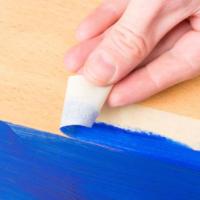Paint a Straight Line for a Professional Finish
by Guest Post on Mar 26, 2010
It can honestly be said that sometimes something as simple as a straight line can make a huge difference. When you are painting, knowing how to paint so that the finish is neat and even can mean the difference between adding value and beauty to your home and taking away from the same. Straight lines and clean trim make the room look professionally styled, and will really improve the overall look of the décor. There are several ways to discover how anyone can paint in a straight line with some care, patience, and effort.
Contrary to everything you learn in painting class, you do not have to paint the room before the baseboards, trim, or molding. In fact, it is better to start by painting these objects instead of finishing with them. It is much simpler to touch up the trim than to go back and touch up walls, and trim touchups are much less noticeable overall.
Start by painting all of the trim, including baseboards, doors/window trim, molding, and similar areas. Give this coat at least one full day to dry, and then add painter’s tape on all sides. You may choose to allow a few more hours for drying if the weather is cool, depending on the area you live in and the quality of paint.
Once the paint is dry, and the tape is applied, paint away in the room. You can do this one wall at a time, or do all four walls at once, depending on your schedule or budget requirements. Make sure that the entire room has had at least a few hours to dry before you remove the tape from the trim. In most cases, it is best to wait about eight hours, and then remove a test strip in a less conspicuous part of the room. This will ensure that your paint does not come off with the tape.
After you remove the tape, touch up any areas that need some work. Allow it to dry, and the room is ready for furniture and accessories. Remember to allow extra drying time during the winter or cold weather, since it takes longer, and for larger rooms. If you are painting the ceiling, consider doing that immediately after the trim, to prevent drip mistakes on the walls after they are completed.
If you are painting a rough wall, add a coat of base paint to the tape to prevent bleeding. Bright colors tend to bleed more, so make sure that the base paint is the shade of the wall or trim under the tape for best results. Press down firmly on the tape, and paint with a wider brush to ensure maximum efficiency and professional results.
Surrounding areas that are wood, smooth, or paneled need special attention. Instead of tape and paint, add clear acrylic varnish as the base coat over the paint. If there is any bleeding, it will be absorbed into the clear coat instead of seeping into the surrounding area and creating a mess that is nearly impossible to fix completely.
Popular Articles
Three Places to Spend Money on the Exterior of Your Home
When you have the exterior of your home remodeled, you are investing, time, energy and convenience into the project and you want to make sure that...
101082 Views
Homemade Headboards-Make an Upholstered or Wooden Headboard
Homemade headboards can add a lot of personality to any bedroom. They can be coordinated with existing furniture and room decor or they can be the...
76655 Views
When to Use a Brush, Roller or Sponge Brush
Brushes are a good choice for painting trim and woodwork. They are also useful for cutting in the edges around the top and bottom edges and corners...
72579 Views
Creating a Cottage Kitchen with Bead Board
Kitchen decor can range from modern and bold to elegant and elaborate by using strategic kitchen pieces. One of the most popular decorating trends...
55086 Views
Gas Fireplace Diagnostics and Troubleshooting
Follow these steps for diagnosing and troubleshooting Gas Fireplaces repairs. For the average DIYer, this may seem intimidating, depending on the...
32192 Views
Latest Articles
How Much Does it Cost to Take a Bath?
Plumbers know that a bath may seem like a relaxing luxury, but the real cost extends far beyond your water bill. The average soak uses 35 to 50...
on Apr 8, 2025
10 Concrete Patio Ideas on a Budget
A concrete patio can be a game-changer for your outdoor space. It is durable, versatile, and can be customized to fit your style. But what if you...
on Mar 25, 2025
Tips for Creating a Stunning Personalized Photo on Canvas
Order the unique beauty of a personalized photo on canvas and bring your memories to life. With a customized photo on canvas, you can transform...
on Mar 7, 2025
Best Areas to Buy Property in Singapore for Long-Term Growth
Singapore's real estate market remains one of the most stable and lucrative in the world. With limited land supply, strong governmental...
on Feb 18, 2025
Troubleshooting Excess Water in Your HVAC Secondary Condensate Drain Pan
When maintaining your air conditioning system, it is easy to overlook the condensate drain pan - until excess water starts pooling in places where...
on Jan 12, 2025
Featured Articles
What Type of Licensed Contractor Should You Hire?
on Feb 28, 2017
Hire Contractors / Estimates

Looking for a specialty project? There are many types of contractors available for your home improvement needs. Finding the right type of...
Sponsored Articles
Best Areas to Buy Property in Singapore for Long-Term Growth
on Feb 18, 2025
Real Estate / Finance

Singapore's real estate market remains one of the most stable and lucrative in the world. With limited land supply, strong governmental...
Actions
Top Categories
- Garden / Landscaping / Patio — 264
- Kitchen / Bathrooms — 240
- Real Estate / Finance — 203
- Appliance / Repair — 186
- Interior Design / Decor — 184
- HVAC / Air Conditioning — 148
- Cleaning / Maintenance — 144
- Improvements / Remodeling — 131
- Plumbing / Basements — 118
- Floors / Tile / Hardwood — 116
- Doors / Garages — 113
- Safety / Security — 113
Articles Archive
More DIY Articles
Decorate Your Home with Contemporary Styles
Home decoration is a must as the home reflects our personality. Home decorating could be done in various ways. As there are different decorating...
Factors to Consider Before Buying Bathroom Furniture
The right furniture in your bathroom can help your bathroom look spacious and sophisticated. There are many fitted bathroom furniture ideas...
Stainless Steel Kitchen Sink: Ways to Choose
Before buying kitchen sinks, you have to carefully plan the design of your kitchen. And as you are searching for the right sink, it would help if...
Solar Panels for the Home Save Money and Our Environment
The process of fitting solar panels in your house offers a barrage of positive benefits. This is a renewable energy source that takes advantage of...
New Uses for Old Things: 10 Ways to Repurpose Old Items
Our landfills are growing by the second -- but there’s plenty that we can do to help, while also adding some extra functionality or style in our...

